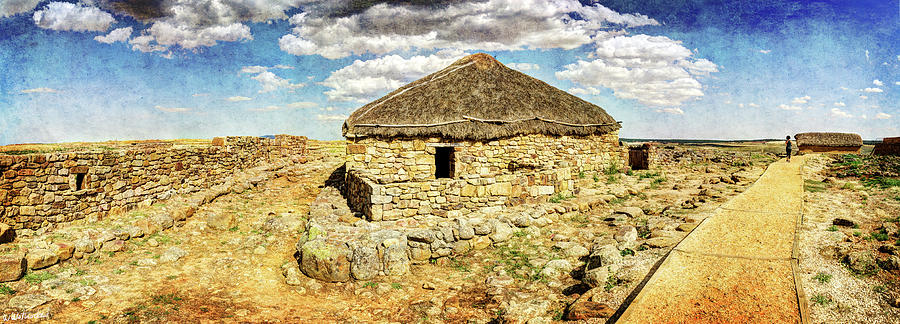
Roman and Celtic houses in Numantia

by Weston Westmoreland
Title
Roman and Celtic houses in Numantia
Artist
Weston Westmoreland
Medium
Photograph - Photograph
Description
Roman and Celtic houses in Numantia.
Panoramic view of the remains of a drywall, street, sidewalks, and a Roman house in Numantia Spain. At the far right, the reconstruction of a Celtiberian house like the ones built there before the Romans came.
The Numantians resisted the Roman invasion over 20 years and inflicted several relevant defeats on the Roman armies, to the point that the day of the year one of these defeats took place was marked on the Roman calendar as a Dies Nefastus, a day in which new campaigns were forbidden to begin.
The first serious conflict with Rome occurred in 153 BC. Numantia took in some fugitives from another Celtiberian tribe. The Romans then besieged Numantia, and deployed a small number of war elephants, but were unsuccessful.
Before their defeat in 133 BC, the Numantians gained a number of victories. In 137 BC, 20,000 Romans surrendered to the Celtiberians of Numantia (population between 4,000-8,000). The young Roman officer Tiberius Gracchus, as quaestor, saved the Roman army from destruction by signing a peace treaty with the Numantines, an action generally reserved for a Legate.
The final siege of Numantia began in the year 134 BC. Scipio Aemilianus, who was a Roman consul at that time, was in command of an army of 30,000 soldiers. His troops constructed a number of fortifications surrounding the city as they prepared for a long siege. Resistance was hopeless but the Numantians refused to surrender and famine quickly spread through the city. After eight months most of the inhabitants decided to commit suicide rather than become slaves. Only a few hundred of the inhabitants, exhausted and famished, surrendered to the victorious Roman legions.
The Romans then built a village on top of the ancient hill-fort, but it had no relevance. It was the crossroads region it dominated and the bold defiance of the Numantians which
The siege of Numantia was recorded by several Roman historians who admired the sense of freedom of the ancient Celtiberians and acknowledged their fighting skills against the Roman legions. In Spanish culture, it has a meaning similar to that of Masada for Israelis. Miguel de Cervantes (author of Don Quijote) wrote a play about the siege, "El cerco de Numancia", which stands today as his best-known dramatic work.
The expression Numantian defence may be used to indicate any particularly obdurate resistance.
The Celtiberians were Celtic-speaking people of the Iberian Peninsula in the final centuries BC.
Archaeologically, the Celtiberians participated in the Hallstatt culture in what is now north-central Spain. Pliny the Elder thought that the original home of the Celts in Iberia was the territory of the Celtici in the south-west, on the grounds of an identity of sacred rites, language, and the names of cities.
Celtic presence in Iberia likely dates to as early as the 6th century BC, when the hill-forts evinced a new permanence with stone walls and protective ditches. There were Celts in the Iberian peninsula as far as Cadiz, bringing aspects of Hallstatt culture while adopting much of the culture they found. This was a culture of seasonally transhumant cattle-raising pastoralists protected by a warrior elite, similar to those in other areas of Atlantic Europe, centered in the hill-forts, locally termed castros, that controlled small grazing territories. Settlements of circular huts survived until Roman times across the north of Iberia, from Northern Portugal, Asturias and Galicia through Cantabria and northern Leon to the Ebro River.
You can learn more about what drives me in my blog:
http://inspiringthoughtsandimages.com/
Weston Westmoreland
Uploaded
October 4th, 2016
Statistics
Viewed 539 Times - Last Visitor from Cambridge, MA on 04/25/2024 at 3:01 AM
Embed
Share
Sales Sheet























































